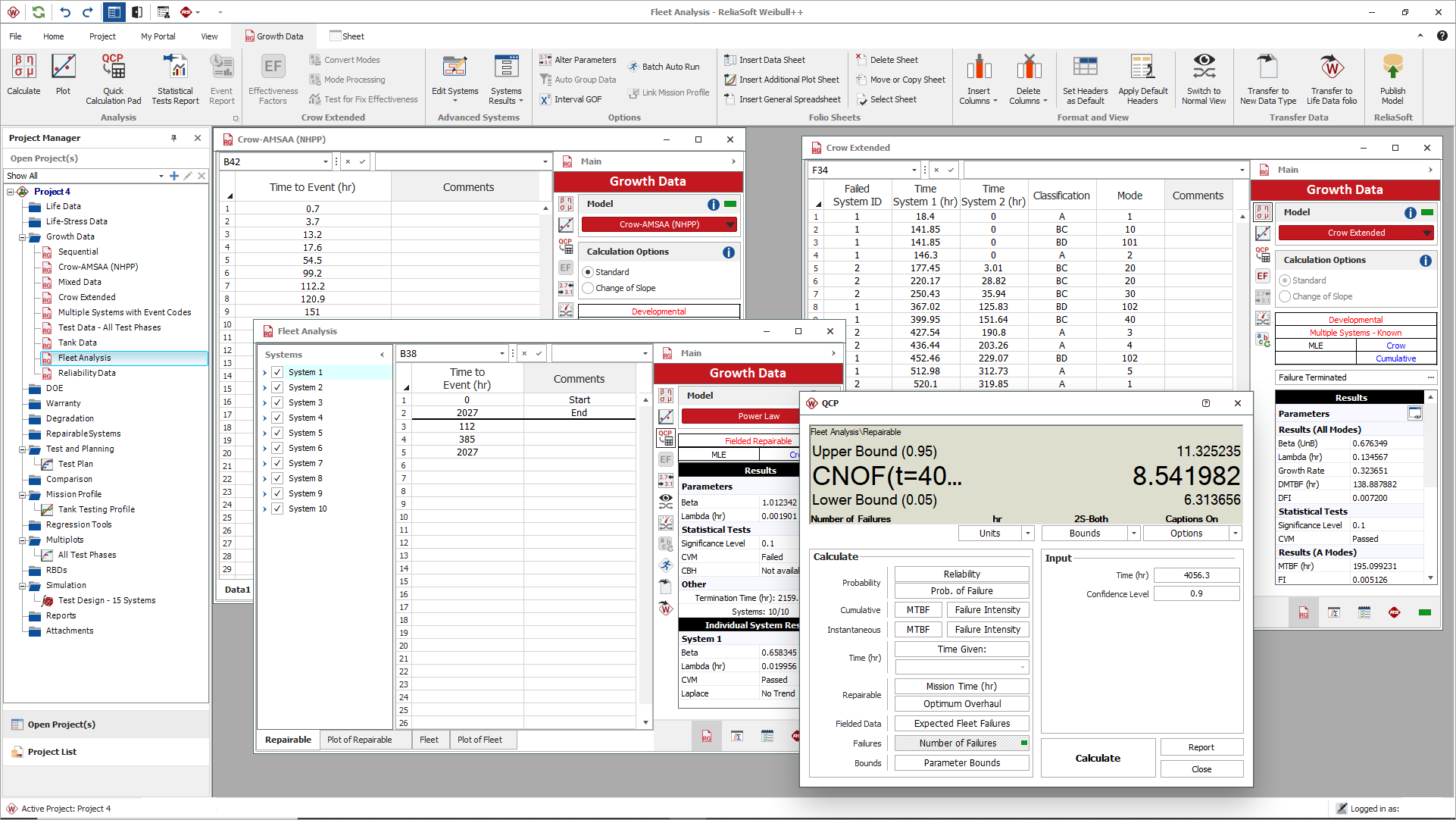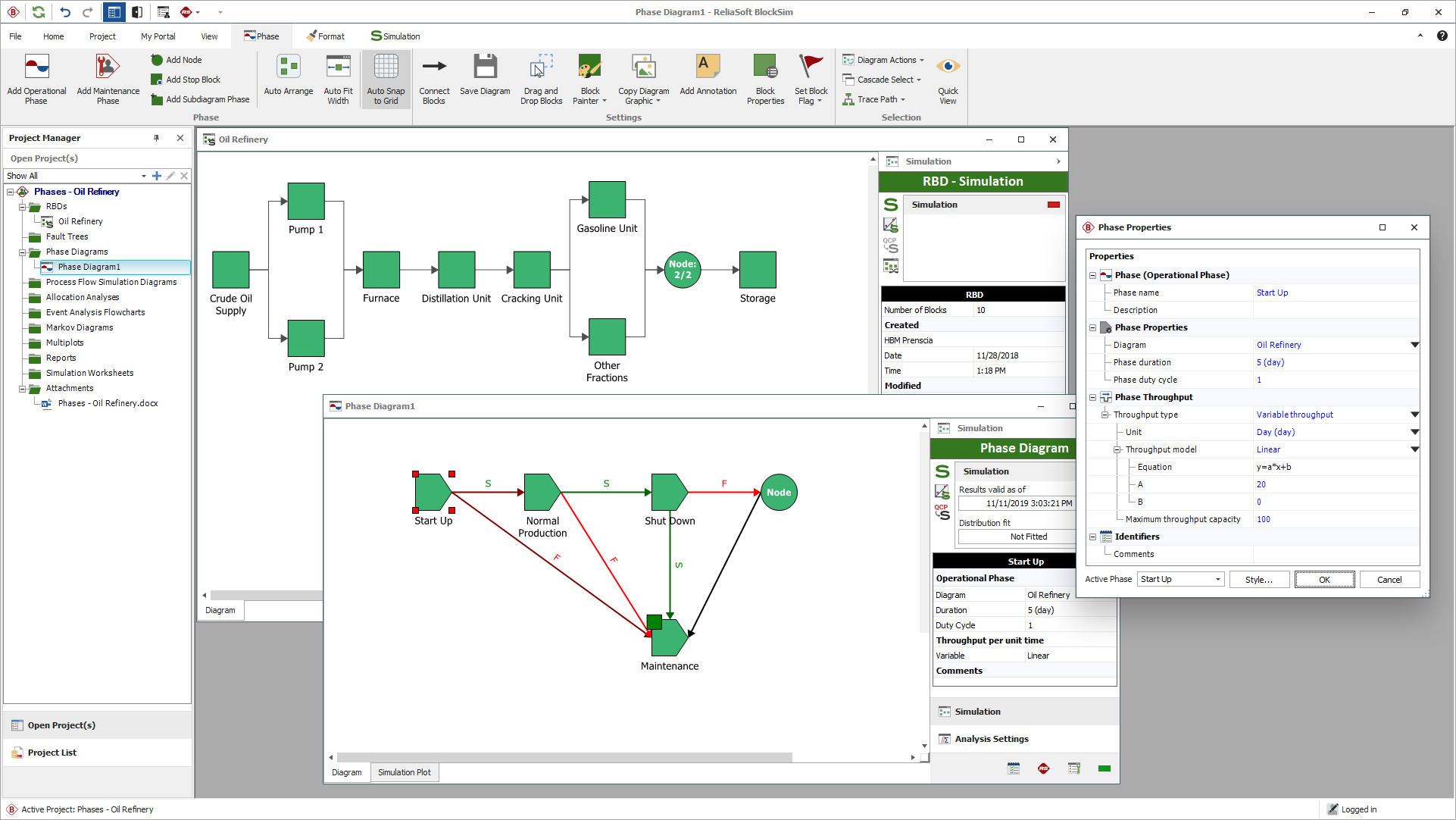Reliability Growth module
Reliability Growth module, formerly known as RGA software, is available in ReliaSoft Weibull++ that allows you to apply reliability growth models to analyse data from both developmental testing and fielded repairable systems.
Reliability Growth module
Reliability Growth module, formerly known as RGA software, is available in ReliaSoft Weibull++ that allows you to apply reliability growth models to analyse data from both developmental testing and fielded repairable systems.

During the development phase, Reliability Growth module allows you to quantify and track the system’s reliability growth across multiple test phases, while also providing advanced methods for reliability growth projections, planning and management. For systems operating in the field, you can calculate optimum overhaul times and other results without the detailed data sets.
Key Capabilities:
- Predict failures before they occur
Forecast failures with reliability growth analysis and make reliability growth projections to evaluate the reliability growth management strategy. - Calculate optimum overhaul times
Easily determine the amount of testing required to demonstrate a specified MTBF, failure intensity, or reliability without the detailed data sets that would normally be required for repairable system analysis. - Design test plans for repairable systems
Determine the test time required per system in order to demonstrate a specified reliability goal. - Monitor reliability improvements over time
Determine the feasibility of achieving a target MTBF with a given management testing strategy. Evaluate the reliability improvement from rolling out fixes for a fleet of units operating in the field. - Quantify reliability growth across multiple test phases
Effortlessly perform reliability growth projections, reliability growth program planning and multi-phase reliability growth analysis. - Experiment with sample sizes with simulation tools
Automatically analyse and plot results from a large number of data sets that have been created via simulation. Perform a wide variety of reliability tasks with integrated simulation tools.
See All Functionality
Reliability growth analysis models
Reliability Growth module supports all of the traditional reliability growth analysis models, such as:
- Crow-AMSAA (NHPP)
- Duane
- Standard and Modified Gompertz
- Lloyd-Lipow
- Logistic
Reliability growth projections, planning and management
Reliability Growth module supports several innovative approaches that expand upon traditional reliability growth methods in ways that better represent real-world testing practices and practical applications.
- The Crow Extended model allows you to classify failure modes based on whether and when they will be fixed. This allows you to make reliability growth projections and evaluate the reliability growth management strategy.
- The Growth Planning Folio helps you to create a multi-phase reliability growth testing plan. In addition, you can use the Crow Extended – Continuous Evaluation model to analyse data from multiple test phases and create a Multi-Phase Plot to compare your test results against the plan. This will help to determine if it is necessary to make adjustments in subsequent test phases in order to meet your reliability goals.
- The Discrete Reliability Growth Planning folio allows you to develop the overall strategy for one-shot devices.
- The Mission Profile Folio helps you create a balanced operational test plan and track the actual testing against the plan to make sure the data will be suitable for reliability growth analysis.
- An MIL-HDBK-189 planning model is available in the Continuous Growth Planning folio.
Reliability growth data types
Times-to-failure data
When you have data from developmental testing in which the systems were operated continuously until failure, you can use the Crow-AMSAA (NHPP) or Duane models. This module provides a choice of data types for individual or grouped failure times, and also for combining data from multiple identical systems. This can include situations, where all systems operate concurrently, you have recorded the exact operating times for both the failed and non-failed systems or you have recorded the calendar date for each failure so you can estimate the operating times of the non-failed systems based on the average daily usage rate for the relevant time period.
With the Crow-AMSAA (NHPP) model, there are additional analysis options for certain situations, such as Gap analysis (if you believe that some portion of the data is erroneous or missing) or change of slope (if a major change in the system design or operational environment has caused a significant change in the failure intensity observed during testing).
Discrete data (also called attribute, one-shot or success/failure data)
When you have data from one-shot (pass/fail) reliability growth tests (and depending on the data type), the module supports Mixed data models that can be used with Crow Extended and Crow Extended-Continuous Evaluation models. For discrete data, the software provides a choice of data types that can handle tests in which a single trial is performed for each design configuration, multiple trials per configuration, or a combination of both. The module also supports Failure Discounting if you have recorded the specific failure modes from sequential one-shot tests.
Reliability data
When you simply wish to analyse the calculated reliability values for different times/stages within developmental testing, you can use the Standard Gompertz, Modified Gompertz, Lloyd-Lipow or Logistic models.
Failure mode classifications and effectiveness factors
Although traditional reliability growth analysis requires the assumption that all design improvements are incorporated before the end of the test (test-fix-test), many real-world testing scenarios may also include some failure modes that are not fixed, and others where some or all of the fixes are delayed until a later time (test-fix-find-test or test-find-test).
With the Crow Extended and Crow Extended – Continuous Evaluation models, you can use Failure Mode Classifications to provide the appropriate analysis treatment for any of these management strategies. For delayed fixes, both models use Effectiveness Factors to indicate how much the failure intensity of each mode will be reduced once the fix has been implemented.
Reliability growth analysis results, plots and reports
For traditional reliability growth analysis, you can calculate the MTBF, failure intensity or reliability for a given time/stage. You can determine the amount of testing that will be required to demonstrate a specified MTBF, failure intensity or reliability. Additionally, you can estimate the expected number of failures for a given time/stage. The module makes it easy to create a complete array of plots and charts to present your analysis graphically.
Fielded repairable system analysis
The Reliability Growth module provides opportunities for fielded repairable system analysis. It can be used to analyse data from repairable systems operating in the field under typical customer usage conditions. Such data might be obtained from a warranty system, repair depot, operational testing, etc. Specifically, you can use the Power Law or Crow-AMSAA (NHPP) models for repairable system analysis based on the assumption of minimal repair (i.e., the system is “as bad as old” after each repair) to calculate a variety of useful metrics, including:
- Optimum overhaul time for a given repair cost and overhaul cost
- Conditional reliability, MTBF or failure intensity for a given time
- Expected number of failures for a given time
- Time for a given conditional reliability, MTBF or failure intensity
- Expected fleet failures calculation for the number of failures that are expected to occur for all systems by a specified time
You can also use the Crow Extended model for fielded repairable systems if you want to evaluate the improvement (i.e., the jump in MTBF) that could be achieved by rolling out a set of fixes for all systems operating in the field.
Reliability test design for repairable systems uses the NHPP model to determine the test time required per system (or the number of systems that must be tested) in order to demonstrate a specified reliability goal, defined in terms of MTBF or failure intensity at a given time.
Operational mission profiles make sure that the testing is applied in a balanced manner that will yield data suitable for reliability growth analysis. Mission Profile folios can help you to create an operational test plan, track the expected vs. actual usage for all mission profiles and verify that the testing has been conducted. It helps you automatically group the data at specified “convergence points” so the growth model can be applied appropriately.
Monte Carlo simulation
Create data sets that can be analysed directly in one of Reliability Growth’s standard folios. You can also use the SimuMatic® utility to automatically analyse and plot results from a large number of data sets that have been created via simulation. These integrated simulation tools can be used to perform a wide variety of reliability tasks, such as:
- Designing reliability growth tests
- Obtaining simulation-based confidence bounds
- Experimenting with the influences of sample sizes and data types on analysis methods
- Evaluating the impact of allocated test time
Integrate repairable systems analysis with other processes
The Reliability Growth module facilitates the analysis of repairable systems data using the Crow (AMSAA) model. It allows you to get an overview of the system without having the large data requirements that would normally be required for system reliability analysis.
With the Reliability Growth module, you can track the progress of the system during development phase and then use ReliaSoft BlockSim in accordance with the already known results to gain more detailed information.



